Report 4 7 November – 4 December 2019
This is the fourth in a series of weekly reports from the Centre for Research in Communication and Culture, Loughborough University on UK wide television and print media reporting of the 2019 UK General Election. These reports are published weekly throughout the campaign.
Report authors
David Deacon, Jackie Goode, David Smith, Dominic Wring, John Downey, Cristian Vaccari
Executive summary
At the start of the week, Boris Johnson expressed his concern in an interview with the Sun’s political editor that ‘people have slightly lost their focus on the political crisis that we face. Unless we get this thing done, unless we get Brexit done, this country cannot move forward. And I think maybe we need to bring that back’.
Our findings confirm that the reduced media emphasis on Brexit noted in previous weeks continues to gather pace. Brexit is no longer the most prominent substantive policy issue in national media coverage, even though issues that are directly related to its implementation gained considerably greater prominence in the penultimate week of the campaign (e.g. the future of the NHS). Brexit has become increasingly part of the background context of the campaign rather than its focal point.
We also compare the prominence of issues in the mainstream media with those emphasised by the two main political parties in their official twitter feeds. The analysis of party-based messages demonstrates the stark differences in the issue agendas of the Conservatives and Labour and that, for the period sampled, aggregate press and TV coverage have tended align more closely with the Conservative agenda. These are aggregate findings and need to be interpreted alongside the weekly volatility of the issue agenda we identify in the first section of this report.
Newspaper negativity towards Labour has intensified slightly more from the high levels observed in the previous three weeks. However, it hasn’t been a great week for the Conservative party. Although the party can still rely on staunch support from some of the most popular selling newspapers, the unweighted data shows that negative coverage of the Conservatives doubled in week 4 compared with week 3.
There is no sign that the two-party squeeze in press coverage in the penultimate week of campaigning. The Brexit party have almost vanished in proportional terms and all the other minor parties have struggled to gain any significant newspaper presence.
The picture is less narrowly defined in television coverage, with the Liberal Democrats and the SNP cumulatively accounting for 1 in 5 of all-party political appearances.
In both press and TV appearances, Boris Johnson and Jeremy Corbyn are attracting almost identical levels of media presence, as are other representatives of their parties. Of course, in press terms at least, this quantitative equality masks significant qualitative inequalities.
This report has 5 sections:
- The issue agenda of the media campaign
- Issue alignment between media and party agendas
- Newspaper evaluations of the parties
- The top twenty most reported politicians
- Prominence of parties
The results in this report are drawn from a detailed content analysis of election coverage produced on the weekdays (i.e. Monday to Friday inclusive) between 7th November and 4th December. The media sampled were:
Television: Channel 4 News (7pm), Channel 5 News (6.30pm), BBC1 News at 10, ITV1 News at 10, Sky News (10-10.30pm).
Press: The Guardian, The I, The Daily Telegraph, The Times, The Financial Times, The Daily Mail, The Daily Express, The Mirror, The Sun, The Star
All election-related news items in the television programmes were analysed. For the press, all election news found on the front page, the first two pages of the domestic news section, the first two pages of any specialist election section and the page containing and facing the papers’ leader editorials were coded. For more details on the methodology of the study see https://www.lboro.ac.uk/news-events/general-election/. Intercoder reliability tests were conducted on all key variables and are ongoing.
Grateful thanks to our coding team: Eleanor Beestin, Jack Joyce, Gabriel Knott-Fayle, Sarah Lewis, Han Newman, Dayei Oh, Nathan Ritchie, Louise Tompkins and Yingzi Wang.
Section 1: The issue-agenda of the media campaign
Table 1 compares the prominence of all issues in TV and newspaper coverage across weeks 1, 2, 3 and 4 of the formal campaign.
Table 1: Issues in week 1 – 4
| Week 1 | Week 2 | Week 3 | Week 4 | |
|---|---|---|---|---|
| % | % | % | % | |
| Arts / culture / sport | 0.0 | 0.0 | 0.1 | 0.1 |
| Business / economy / trade | 8.7 | 10.4 | 6.5 | 9.6 |
| Constitutional / legal / judicial issues | 1.1 | 0.9 | 0.3 | 1.6 |
| Standards / corruption / scandals / sleaze | 2.9 | 3.3 | 9.0 | 7.3 |
| Crime / law and order | 0.4 | 2.2 | 0.5 | 3.1 |
| Defence / military / security / terrorism | 3.8 | 1.9 | 0.8 | 8.5 |
| Education | 1.4 | 0.5 | 1.3 | 1.3 |
| Electoral process | 40.5 | 29.5 | 26.0 | 28.2 |
| Employment | 1.4 | 2.0 | 0.8 | 1.2 |
| Environment | 2.9 | 4.1 | 2.1 | 3.2 |
| Brexit | 16.2 | 12.7 | 11.0 | 6.7 |
| Other EU | 0.1 | 0.4 | 0.0 | 0.0 |
| Farming / agriculture | 0.2 | 0.4 | 0.1 | 0.1 |
| Other foreign policy | 0.1 | 0.1 | 0.4 | 2.0 |
| Media policy issues | 0.2 | 1.4 | 0.3 | 0.6 |
| Health and health care | 4.4 | 8.5 | 5.8 | 9.4 |
| Housing / property issues | 0.2 | 0.6 | 2.4 | 0.3 |
| Local Government in UK | 0.4 | 0.2 | 0.0 | 0.1 |
| Scotland / Wales / NI | 2.0 | 2.5 | 2.4 | 0.7 |
| Public services | 3.0 | 2.1 | 6.0 | 2.4 |
| Immigration / border controls | 2.3 | 4.5 | 0.7 | 1.7 |
| Minorities / religion / sexuality | 1.8 | 1.9 | 7.2 | 4.2 |
| Social Security | 1.2 | 1.2 | 3.0 | 1.8 |
| Taxation | 2.7 | 6.9 | 10.6 | 3.5 |
| Transport | 0.5 | 0.6 | 1.2 | 1.8 |
| Women’s issues | 1.1 | 0.6 | 0.6 | 0.1 |
| Other | 0.2 | 0.6 | 0.6 | 0.2 |
Note: percentages = (number of appearance of an issue/ all issues *100)
Key findings
- The most striking finding is the reduced prominence of Brexit as a substantive theme in the fourth week of the campaign - nearly halving its presence from last week (11 percent of all issues in week 3 to 6.7 percent in week 4).
- This may be partly explained by news organisations preparedness to diversify coverage of the campaign away from an issue that dominated the early stages of the election as well as the impact of other important external events such as the terrorist attack and the 70th anniversary NATO summit.
- That said, it also reflects how Brexit has become a more latent than manifest element in some coverage. For example, several Health/ Health service items linked to discussion of hypothetical post-Brexit trade deals (e.g. President Trump’s comments at the start of the NATO summit that the US wants ‘nothing to do with the NHS’). But for such items also to be coded as Brexit-related there had to be a clear and substantial reference made to the UK’s withdrawal from the EU. Reporting of hypothetical future trading scenarios and their implications for public health provision were insufficient on their own to gain a ‘Brexit’ allocation.
- This growth of more allusive referencing to Brexit shows how the issue has become more of a contextual factor than a focal point of much electoral coverage: at once everywhere yet nowhere.
- Coverage of ‘Business/ Economy/ Trade’ is now the largest substantive policy theme (9.6 percent).
- ‘Health/ Health Care’ is the second most prominent theme at 9.4 percent, reasserting its presence having fallen away in week 3.
- ‘Defence/ security/ terrorism’ received 10 times more coverage in Week 4 than Week 3. This is explained by the terrorist attack in London on Friday and the NATO 70th anniversary summit held in Watford earlier this week.
- These links were often reported as highly contentious. This is demonstrated by the ongoing prominence of issues concerning ‘standards/ corruption/ scandals/ sleaze’ (7.3 percent). In week 3 this category captured the controversy surrounding antisemitism and the Labour party (see also the linked category ‘Minorities/ religion/ sexuality’). These allegations continued into week 4 but were surpassed by criticisms of politicians who allegedly sought to make electoral capital out of the terrorist murders committed on 29 November.
- Coverage of the ‘electoral process’ itself remained at the previous week’s levels (28 percent).
- Taxation coverage reduced sharply in the fourth week (3.5 percent down from 10.6 percent).
- Environment coverage remains low (3.2 percent). This is not to say there has not been a significant amount of environment related coverage during the campaign. The low figure here reflects the fact that many of these items have a global rather than local emphasis and do not specifically refer to the current election campaign.
Section 2: Issue alignment between party agendas and media agendas
An additional component of our media analysis this week is an analysis of tweets sent by the party and leader accounts of the Conservatives and Labour. Aside from their intrinsic interest, these data provide a basis for calibrating the alignment between media and party issue agendas.
We have included in our analysis all tweets sent by the accounts of the Conservatives (N=325), Boris Johnson (N=158), Labour (N=298) and Jeremy Corbyn (N=148) from around the mid-point of the campaign (18th November) to Tuesday of this week (3rd December).
We have sampled weekdays for consistency with the mainstream media sample and to enable comparisons (below) with the agenda balance of media coverage. We have included original tweets only in our analysis – retweets do not form part of this sample.
Figure 2.1 aggregates tweets from the party and leader accounts of each party to compare the percentage thematic focus of tweets sent by these accounts across the top ten themes overall.
Figure 2.1: Top 10 themes in Conservative and Labour party tweets (18 November - 3 December 2019)

Note: up to two themes could be coded per tweet. ‘Electoral process’ themes have been eliminated from the analysis to include instead only those categories focusing on substantive issues. Percentages add up to 100 within each party’s tweeted themes.
Key findings
- The results demonstrate that the two parties have chosen to focus on very different issues during the sample period. Discussion of public services – the 7th most prominent category within the tweet sample – is the only theme for which there is broad parity of emphasis.
- All other thematic categories are dominated by one or the other party. Brexit, taxation, crime/law and order and immigration are the Conservative Party’s key electoral issues, while Labour have chosen to focus on healthcare, business/economy/trade, the environment, social security and housing.
Figure 2.2 illustrates the distribution of the top five themes within TV, red top, mid-market and quality newspapers during the same sample period.
(Note: these samples dates are different from the data shown in section 1.)
Figure 2.2: Top 5 themes across media sectors
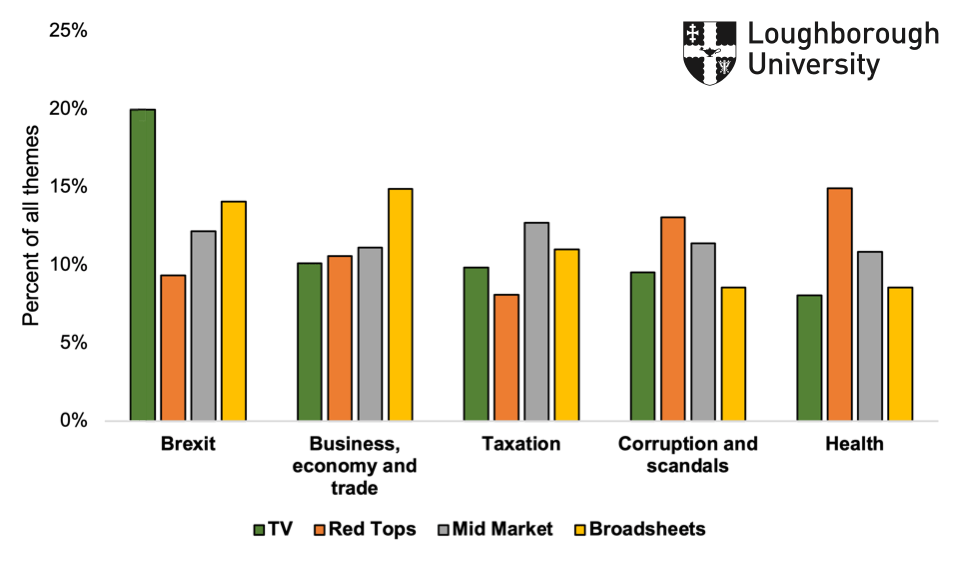
Notes: ’Red Top’ press=The Mirror, Star and Sun; the Mid-Market press=Mail, Express and the I, Broadsheets=Guardian, Times, FT and Telegraph.
Key findings
- The media issue agenda in this period in thematic terms was remarkably consistent across the sectors: Brexit, business/economy/trade, taxation, corruption and scandals, and health were all in the top five in each of the four media sectors.
- While the first and third of these issues have been covered heavily by the Conservatives in their Twitter activity, the second and fifth have been covered more consistently by Labour.
- TV coverage has focused far more on Brexit than on any other issue: 20 percent of coded themes have been about Brexit on TV, compared with only between 8 percent and 10 percent of the other top five issues.
- Within print media, the broadsheet press have focused on Brexit and business/economy/trade the most, while the mid-market titles have covered taxation more than other newspaper types and the red tops have focused more heavily on corruption and scandals, and health.
- In proportional terms, TV coverage has therefore tended to align most closely with the Conservatives’ Brexit agenda than the press. This difference may be partly explained by the more limited news space available in TV coverage compared to newspapers.
Figure 2.3 shows the percentage of Conservative and Labour tweets that promoted their own party or leader, attacked an opponent, or defended their party or leader from the attacks of opponents. This illustrates the tenor of debate between the two parties and the extent to which they have focused on promoting their own policies versus attacking their opponents.
Figure 2.3: Promoting, attacking and defending tweets
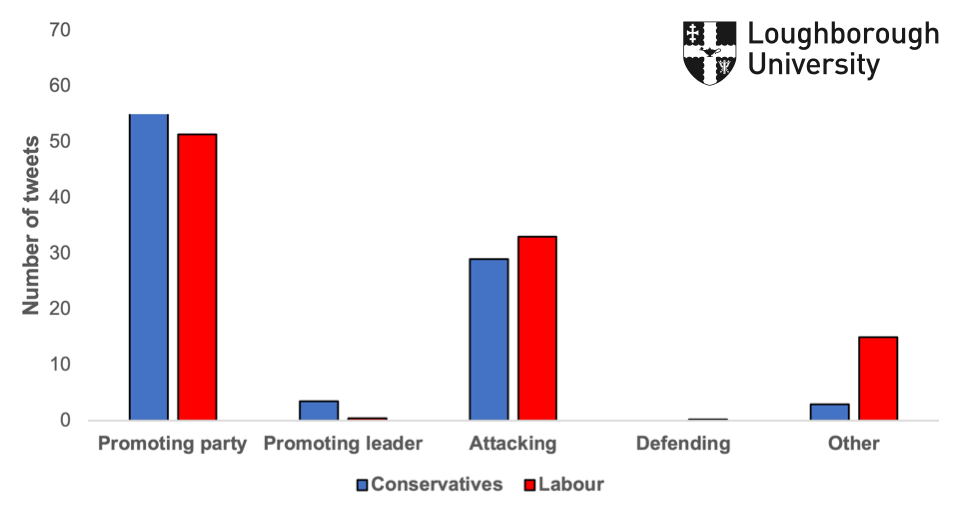
Figure 2.4 disaggregates the instances in which tweets are attacking opponents to consider who is being attacked. Multiple instances of attacking opponents could be coded per tweet, so the absolute figures of each instance are provided (rather than percentages).
Figure 2.4: The targets of attacking tweets
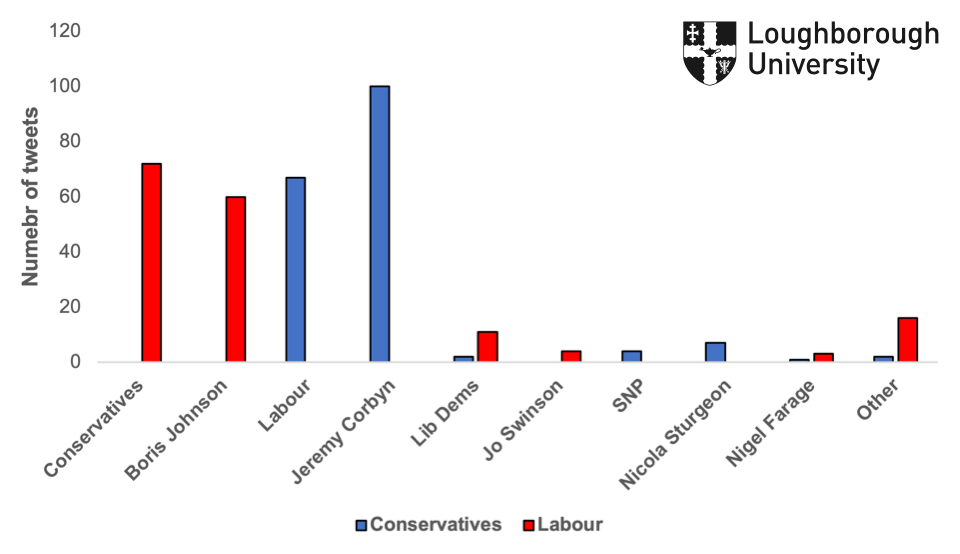
Note: Coders were asked to select as many targets as may apply in a given tweet.
Key findings
- Overall, approximately 60 percent of party/leader tweets have promoted the party’s policies, election strategies or leader, while in 31 percent of cases tweets primarily functioned to attack opponents.
- Instances of ‘attack tweets’, show that each party has tended to expend most of their criticism on attacking each other’s party or leader.
- Conservative party/leader tweets have more often attacked Jeremy Corbyn than Labour party/leader tweets have attacked Johnson.
- The Lib Dems and Jo Swinson have received criticism from Labour more often than from the Conservatives while there have also been a small number of Conservative/Johnson tweets attacking the SNP and Nicola Sturgeon.
- Labour have also on several occasions attacked other actors in the election debate, such as Donald Trump.
Section 3: Newspaper evaluations of political parties
In this section we discuss the overall positivity or negativity of newspaper coverage. For each item we assessed whether the information or commentary contained within it had positive or negative implications for each political party1.
Scoring
- Each party was separate rated in each election item.
- If an item mainly or solely focused on positive matters for a party, it was given a value of +1.
- If it mainly/ solely focused on negative matters for a party, it was assigned a value of -1.
- Items where there was (a) no clear evaluation, (b) contained positive and negative issues in broadly equal measure or (c) no mention of the party was made, were coded as zero.
- Items where no reference was made to the party were excluded from the calculation.
The scores in Figure 3.1 are calculated by subtracting the total number of negative stories from the total of positive stories for the 5 main parties for each of the three weeks of the campaign.
The scores in Figure 3.2 weight these figures by press circulations (where 1=1 million), using the same weekly division.
1 This is not solely a measure of overt support or criticism by a journalist of a party (although these instances would be included in the count). It is a broader measure of the extent to which newspapers report on issues/ comments/ developments that have positive or negative implications for parties. We only coded these instances where these were overtly referred to in the piece.
Figure 3.1: Overall newspaper evaluations weeks 1 - 4 (unweighted)

Figure 3.2: Overall newspaper evaluations - weeks 1 - 4 (weighted by circulation)
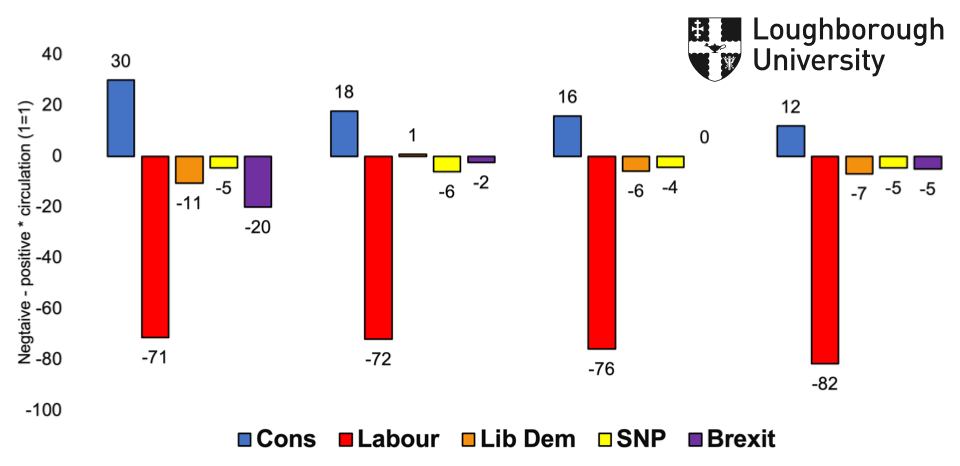
Key findings
- The overall high level of negativity towards the Labour Party has remained constant throughout the election campaign, increasing week-by-week. Manifesto and policy announcements have not managed to reverse this trend over the course of the campaign.
- Unweighted coverage of the Conservative Party started off overall as mildly positive but has progressively become more negative over the course of the campaign and increasingly so in the aftermath of the London Bridge terrorist attack. Negative coverage more than doubled in week 4.
- Weighted coverage remains positive for the Conservative Party because of the high circulation of the Sun and Daily Mail, Conservative supporting newspapers.
- It is noteworthy the extent to which this election is presented as a two-horse race between Labour and Conservative parties. Initial more negative coverage of the Brexit Party and the Liberal Democrats has declined, which might be an indication that they are now seen as increasingly irrelevant for the election outcome.
Section 4: Top twenty politicians
Table 4.1 reviews the individual campaigners who have been most prominent in the election this week. The Top 20 also details changes in the list along with new entrants.
Table 4.1: Most prominent campaigners in week 4
| Wk 4 | Wk 3 | ||
|---|---|---|---|
| 1 (1) | Jeremy Corbyn (Lab) | 31.7 | 27.7 |
| 2 (2) | Boris Johnson (Con) | 30.9 | 25.9 |
| 3 (3) | Jo Swinson (LibDem) | 4.8 | 5.4 |
| 4 (5) | Nicola Sturgeon (SNP) | 4 | 3.7 |
| 5 (4) | John McDonnell (Lab) | 3.8 | 4.1 |
| =6 (-) | Dominic Cummings (Con) | 3 | - |
| =6 (=8) | Matt Hancock (Con) | 3 | 2.3 |
| 8 (7) | Priti Patel (Con) | 2.4 | 2.6 |
| =9 (-) | Sian Berry (Green) | 1.6 | - |
| =9 (-) | Iain Duncan Smith (Con) | 1.6 | - |
| =9 (=13) | Adam Price (PC) | 1.6 | 1.2 |
| =12(12) | Jonathan Ashworth (Lab) | 1.3 | 1.6 |
| =12 (-) | Richard Burgon (Lab) | 1.3 | - |
| =12 (=8) | Nigel Farage (Brexit) | 1.3 | 2.3 |
| =12 (=17) | Barry Gardiner (Lab) | 1.3 | 0.8 |
| =12 (=10) | Sajid Javid (Con) | 1.3 | 1.8 |
| =12 (-) | Len McCluskey (Lab/Unite) | 1.3 | - |
| =12 (-) | Dominic Raab (Con) | 1.3 | - |
| =12 (-) | Rishi Sunak (Con) | 1.3 | - |
| =12 (=13) | Chuka Ummuna (LibDem) | 1.3 | 1.2 |
Notes: percentages= individual’s appearance/ total number of items*100
Key findings
- The main party leaders continue to dominate coverage of this campaign. Their prominence continues to remain unchallenged for a further week, and Jeremy Corbyn retains his place at the top of the list. But some of the attention paid to the Labour leader, particularly in the print media, continues to be very hostile towards him, his party and their manifesto.
- Jo Swinson and Nicola Sturgeon, respectively the leaders of the next largest parties in electoral and parliamentary terms, continue to be among the most prominent campaigners but are still some way behind their Labour and Conservative rivals.
- John McDonnell has firmly established himself as a constant presence and Labour’s second most prominent campaigner reflecting both the promotion and criticism of his party’s spending plans. Sajid Javid continues to receive some attention but markedly less than his shadow.
- The LibDem and SNP leaders are two of the four women in this week’s Top 10 but, while this may look slightly more diverse than in previous reports, 16 of the Top 20 are male.
- Reflecting the presidential nature of this campaign, Boris Johnson’s controversial strategist Dominic Cummings make his first appearance in the list, relatively high up the list and above every other Conservative, apart from the Prime Minister himself.
- The impact of the televised debates is reflected in the prominence afforded to several participants including Green co-leader Sian Berry, Richard Burgon, Adam Price and Rishi Sunak.
- The prominence of the debate over health and security is reflected in the prominence of campaigners like Matt Hancock, Priti Patel, and John Ashworth. The decline of Brexit related coverage is reflected in Nigel Farage’s decline to near the bottom of the Top 20.
Table 4.2: Other sources in coverage
| Wk 4 only | ||
|---|---|---|
| 1 | Donald Trump | 8.3 |
| 2 | Academics | 6.7 |
| 3 | Charity/Voluntary Sector | 5.4 |
| 4 | Institute for Fiscal Studies | 5.4 |
| 5 | Businesspeople | 4.8 |
Last week’s report looked at the prominence of experts, a notable feature of the coverage at a time when the rival parties were releasing their manifestos and plans for government. This week has been interesting for the intervention of President Trump. Despite Michael Gove’s observation about the surfeit of expert opinion in the 2016 referendum campaign, academics have enjoyed a considerable amount of media attention as have charity representatives and businesspeople. Economic coverage continues to rely on input from the IFS and its Director Paul Johnson.
Section 5: Prominence of parties
Figure 5.1 compares the levels of coverage of the political parties on TV news during the weekday coverage between 28 November and 4 December inclusive2. Figure 5.2 provides the same comparison for press coverage.
Figure 5.1: Prominence of political parties in TV election coverage in week 4 only (28 November - 4 December)
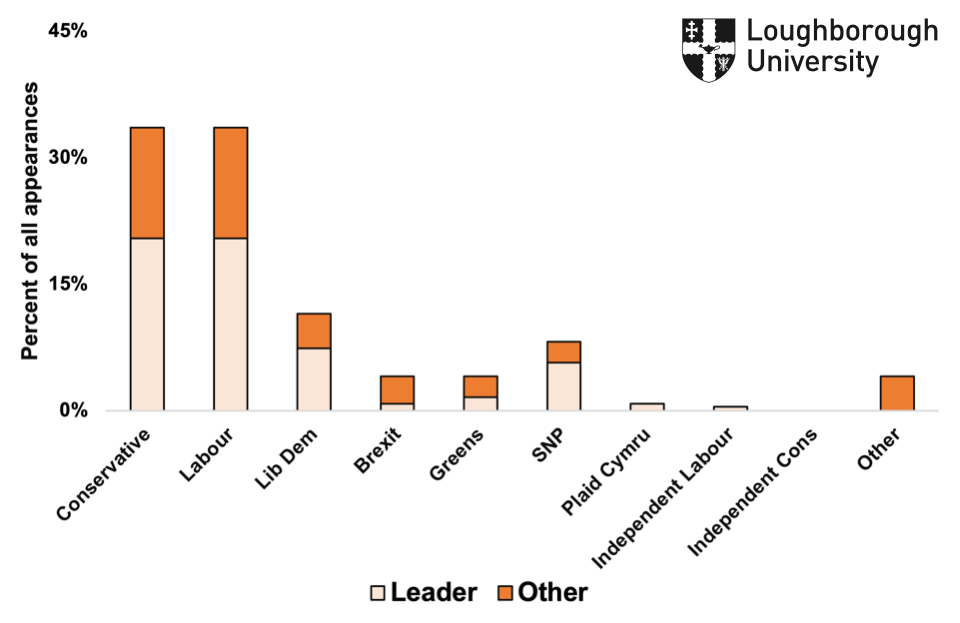
Figure 5.2: Prominence of political parties in newspaper election coverage in week 4 only (28 November - 4 December)
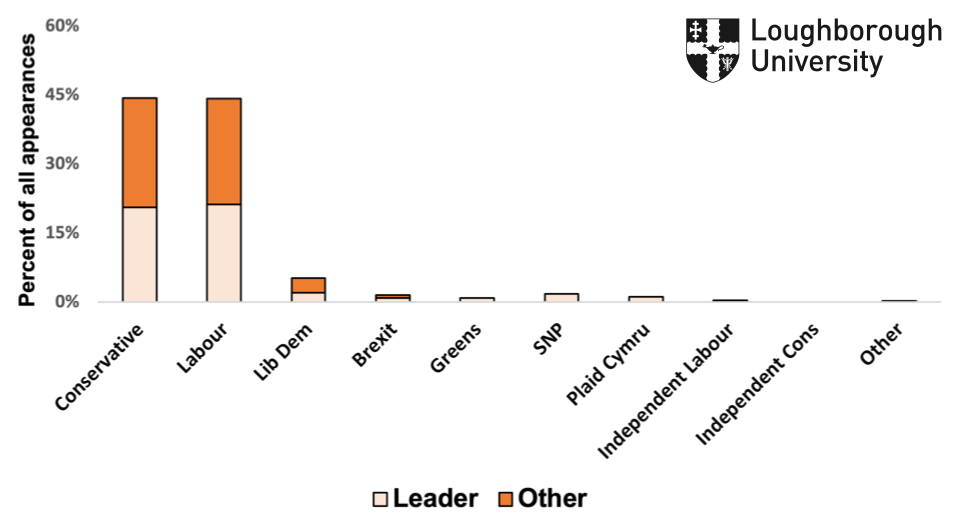
2 To be coded as ‘present’ a political representative needed to have an active role within the item. They could be counted even if they were not quoted, but there had to be a clear and substantial attribution to them of a speech act or action. Up to 5 politicians could be coded per item.
Key findings
- The two-party squeeze continues into the fourth week in national press coverage, with representatives of the two parties commanding 90 percent of appearances.
- The squeeze is not as tight in television news, with the two parties accounting for 66 percent of coverage.
- There is a remarkable parity in the overall amounts of coverage given to the two main parties and their leaders. In both the press and television coverage, their prominence is almost identical.
- Jo Swinson has dominated the Liberal Democrat’s share of TV coverage, reflecting her appearance in the broadcast debate formats.
- Nicola Sturgeon has continued to maintain her profile in broadcast media terms and is by far and away the face of her party when the SNP is represented on television.
- The Brexit and Green parties have enjoyed some broadcast coverage, benefitting from the exposure that has come courtesy of their participation in the key television debates.
- Other parties including potential power brokers in a hung parliament such as the SNP, DUP and Brexit Party, have received scant print media coverage heading into the closing stages of the election.
- Prominent in the press at the start of the campaign, the Brexit Party is virtually anonymous now.